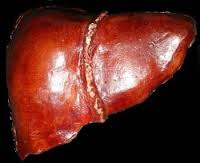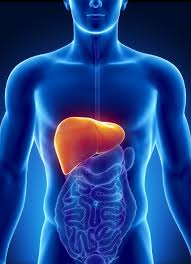The liver is a large, meaty organ that sits on the right side of the belly. Weighing about 3 pounds, the liver is reddish-brown in color and feels rubbery to the touch. Normally you can’t feel the liver, because it’s protected by the rib cage.
The liver has two large sections, called the right and the left lobes. The gallbladder sits under the liver, along with parts of the pancreas and intestines. The liver and these organs work together to digest, absorb, and process food.
The liver’s main job is to filter the blood coming from the digestive tract, before passing it to the rest of the body. The liver also detoxifies chemicals and metabolizes drugs. As it does so, the liver secretes bile that ends up back in the intestines. The liver also makes proteins important for blood clotting and other functions.
The liver is a vital organ of vertebrates and in some other animals. In the human it is located in the upper right quadrant of the abdomen, below the diaphragm. The liver has a wide range of functions, including detoxification of various metabolites, protein synthesis, and the production of biochemicals necessary for digestion.
The liver is a gland and plays a major role in metabolism with numerous functions in the human body, including regulation of glycogen storage, decomposition of red blood cells, plasma protein synthesis, hormone production, and detoxification. It is an accessory digestive gland and produces bile, an alkaline compound which aids in digestion via the emulsification of lipids. The gallbladder, a small pouch that sits just under the liver, stores bile produced by the liver. The liver’s highly specialized tissue consisting of mostly hepatocytes regulates a wide variety of high-volume biochemical reactions, including the synthesis and breakdown of small and complex molecules, many of which are necessary for normal vital functions Estimates regarding the organ’s total number of functions vary, but textbooks generally cite it being around 500.
Nonalcoholic fatty liver disease is a term used to describe the accumulation of fat in the liver of people who drink little or no alcohol.
Nonalcoholic fatty liver disease is common and, for most people, causes no signs and symptoms and no complications.
But in some people with nonalcoholic fatty liver disease, the fat that accumulates can cause inflammation and scarring in the liver. This more serious form of nonalcoholic fatty liver disease is sometimes called nonalcoholic steatohepatitis.
At its most severe, nonalcoholic fatty liver disease can progress to liver failure.
Much of the American Liver Foundation’s emphasis during October continues to point to the cause and treatment for liver diseases like hepatitis A, B and C; cirrhosis, biliary atresia and liver cancer.
Much of the Foundation’s emphasis during October continues to point to the cause and treatment for liver diseases like hepatitis A, B and C; cirrhosis, biliary atresia and liver cancer.
But the Foundation is also tapping into the heightened awareness during Liver Awareness Month to draw attention to the alarming increase in the incidence of Non-Alcoholic Fatty Liver Disease (NAFLD), which, staggeringly, affects up to 25 percent of people in the United States.
As its name suggests, NAFLD is the buildup of extra fat in the liver that isn’t caused by alcohol. It’s normal for the liver to contain some fat. But if more than 5 to 10 percent of the liver’s weight is fat, then it is called a “fatty liver.”
Most often, NAFLD tends to develop in people who are overweight or obese or have diabetes, high cholesterol or high triglycerides. Sedentary behavior is another major contributing factor to the onset of NAFLD.
For these reasons, concern continues to grow as one in 10 children—that’s seven million children in the United States—is estimated to have fatty livers.
NALFD can become even more serious. It can progress to Non-Alcoholic Steatohepatitis (NASH), which means that along with the fat, there is inflammation and damage to the liver. A swollen liver may cause scarring (cirrhosis) over time and may even lead to liver cancer or liver failure.

